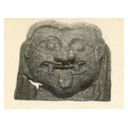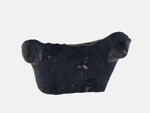Document Content
Daily Log
August 6, 1971
- F-G/29-30: 3T: 12 boxes of tiles
- F/29-30: 3 boxes of tiles
Worked in grids F-H/29-30.
We finished lifting tile layer in G-H/29-30. Pottery was very frequent; much bucchero. A complete gorgon antefix in G/30.
Bones more frequent here than in higher levels, but no extraordinary quantity. At depth of ab. 75 cm below ground surface, we strike upon the same hard carbon-colored batuto surface as this found earlier in grids westwards.
Donato works on in F/29-30, same type of soil as before ( see p. 215 ), yielding little. On a level of ca. 75 cm below ground surface, however, we enter upon what seems to be the upper surface of the lower tile layer which appeared earlier in F-G/
27-28. A very long fragment of a doccia turns up in profile wall forming towards E/30. The tile layer in F-G/29-30 extends likewise south of "stone line" in G/29-30, continuing from G/27-28 eastwards, stones however being smaller and much more irregular. Some of them have a light pink color.
In a strip ab. 50 cm wide along southern side of stone line is found a thick deposit of clay plaster which covers the tiles here. The clay plaster pezzi were lifted carefully, whereby it was possible to observe that most of them were lying with their flat side downwards, the imprints of camae showing upwards.
The tile layer is as thick as in F-G/27-28 and contains the same high quantity of cover tiles. Immediately below, on same level as westwards, was found the same very hard stratum as in F-G/27-28 consisting of gray stone pezzettini forming a very hard surface, except for in grid F/29 where a rounded formation
apparently consisting of light-colored, fairly loose earth was found, rising ca. 10 cm above gray-stone stratum. This round "cake" contained a few pieces of small stones and tile fragments. The gray-stone stratum was heavily colored by carbon on its upper surface, especially in a circle around the round formation.
The tiles were lifted, and work in area T-18 was hastily finished. Polishing and photos remain.
This day's digging gave most interesting results. See summary on p. 251 .
- Find #1
- T-18 G/30
- Gorgon antefix, nearly complete
- Find #7
- T-18 G/29
- Fragment of bucchero handle with plastic decoration of two knobs
- Find #8
- T-18 F/30
- From tile layer in F-G/29-30
- Big fragment of covertile, width preserved, length nearly completely preserved
| Descriptive Attribute | Value(s) |
|---|---|
| Document Type | Trench Book Entry |
| Trench Book Entry Date | 1971-08-06 |
| Entry Year | 1971 |
| Start Page | 224 |
| End Page | 233 |
| Title | Daily Log |
| Descriptive Attribute | Value(s) |
|---|---|
|
Is Part Of
Vocabulary: DCMI Metadata Terms (Dublin Core Terms) |
ER I
Vocabulary: Murlo |
Suggested Citation
Eva Rystedt. (2017) "ER I (1971-08-06):224-233; Daily Log from Europe/Italy/Poggio Civitate/Tesoro/Tesoro 18/1971, ID:70/PC 19710589". In Murlo. Anthony Tuck (Ed). Released: 2017-10-04. Open Context. <https://opencontext.org/documents/98f30702-6815-42ea-bfdb-2c68bcba5720> ARK (Archive): https://n2t.net/ark:/28722/k2qj7qb5w
Copyright License
To the extent to which copyright applies, this content
carries the above license. Follow the link to understand specific permissions
and requirements.
Required Attribution: Citation and reference of URIs (hyperlinks)











